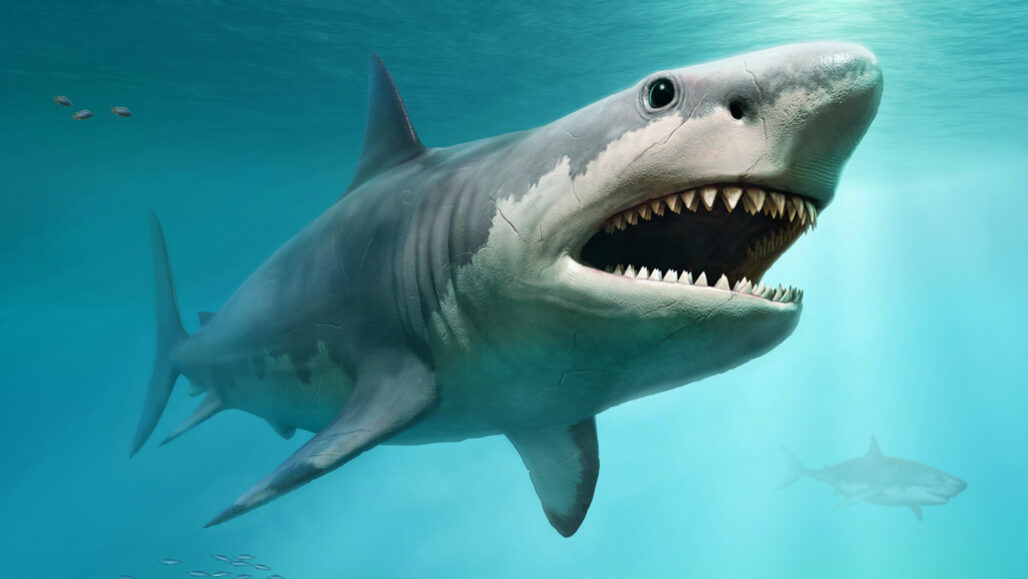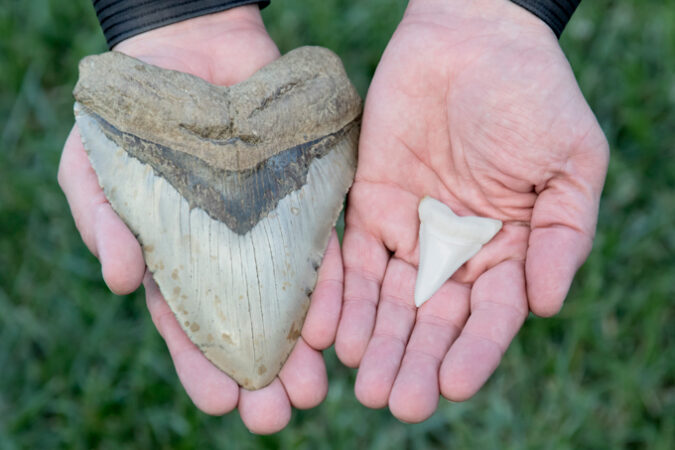Attack of the inner-cannibal mega-shark
History’s largest shark may have gotten mega-sized after eating its unborn siblings

Massive megalodons ruled the seas some 23 million to 2.5 million years ago. Why these giants got so big isn’t known. New research suggests it may be due to warm-bloodedness, lots of food — and cannibalization in the womb.
Warpaintcobra/iStock / Getty Images Plus
Otodus megalodon is a giant among sharks. The 14-meter (45-foot) carnivore with razor-sharp teeth cruised the seas some 23 million to 2.5 million years ago. No other predatory shark has matched its size and ferocity. How did this creature get so ginormous? A group of scientists now suspects part of the reason may be that megalodon ate its siblings while still in its mother’s womb.
They call it intrauterine (In-trah-YU-tur-in) cannibalism. It means the strongest embryo in the womb devours its weaker siblings. Some of megalodon’s living relatives do this, such as great white sharks. Scientists think megalodon and some other ancient sharks did it too.
Kenshu Shimada works at DePaul University in Chicago, Ill. As a paleobiologist, he studies ancient animals. Along with some colleagues, he came up with this out-of-the-box theory: The adults’ size may reflect the appetites of megalodon babies in the womb. Their constant chowing down allowed these ancient beasts to become the largest shark ever to hunt the Earth’s oceans. They were twice the size of a double-decker bus and half as large as today’s whale sharks, filter feeders that can grow to 30 meters (100 feet).
Shimada’s team came up with its cannibalism idea after analyzing modern and ancient shark teeth. Scientists used these teeth to estimate the body sizes of fish. The researchers focused on lamniforms, also known as mackeral shark. About 15 of these species exist today. They include the great white, mako and basking sharks. But throughout history, there have been more than 200 lamniform shark species. Megalodon was the largest of all time.
It wasn’t easy for scientists to figure out its body size. That’s because shark skeletons are made of cartilage. Unlike bone, cartilage doesn’t last long once an animal dies. Luckily, sharks have teeth. Lots and lots of teeth. These remain behind when a shark goes belly up. And those choppers can tell a story of extinct species.
Scientists concluded megalodon was at least 14 meters long. Four other extinct species of lamniforms grew to more than 6 meters (20 feet). That means they also exhibited “gigantism.” While that’s not as titanic as megalodon, it’s still pretty big. Gigantism also occurs in several modern lamniform species.
Exactly why megalodon and its cousins became so big is still a bit murky. Warm-bloodedness — or endothermy — may be one key. Extinct and modern lamniforms are more warm-blooded than other sharks. By regulating their body temperatures, they can swim faster to catch large, speedy prey in cold waters. Warm-blooded sharks also need more food than slower moving, colder-blooded ones. More and bigger food may have allowed these sharks to get bigger.

But that theory doesn’t explain why these sharks were warm blooded in the first place. Shimada and his group say something else must have been at play. Their novel idea: Competition for food in the womb. It could have affected megalodon’s size and body temperature.
Sharks don’t breed like other fish. Most female fish lay eggs outside their bodies. Thousands of them. Males then come by and fertilize those eggs. Sharks embryos instead develop inside the eggs. But the mother squirrels them away in her womb until they are ready to hatch.
This takes a gnarly turn in living lamniform sharks. Unlike other sharks, lamniforms practice intrauterine cannibalism. All living lamniform sharks do this. So Shimada and his colleagues reasoned that ancient ones like megalodon did too.
How does it work? Once the first shark pup hatches inside its mom, it begins gobbling up the remaining eggs. It’s like yet-to-be-born Pacman. As the pup eats, it grows. Its constant feeding also forces its mom to eat more. As she eats more, her waiting-to-be-born pup grows bigger. As that baby packs on the pounds, its body temperature rises. Finally, a large, fattened shark emerges from its mother and swims away.
This study seeks to link tooth, jaw and body size in fossils of extinct lamniform sharks, says Humberto Férron. He is a paleobiologist at the University of Bristol in England. The idea that in-the-womb cannibalism may have contributed to megalodon’s size, he says, “is novel.”
Stephen Godfrey agrees. He’s a paleontologist at Calvert Marine Museum in Solomons, Md. It’s possible that in-the-womb cannibalism helped some lamniforms become warm-blooded in the first place, he says. It could have helped them grow big enough to take on bigger prey. That could have driven a need for more energy and evolutionary change, such as warm-bloodedness.
But it still doesn’t fully explain the unique super-gigantism of megalodon, Godfrey adds. “If there had been no large prey, I very much doubt that there would have been macro-predatory giant sharks,” he says.
Clearly, this is no ordinary fish tale.







